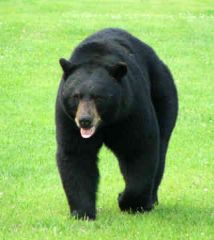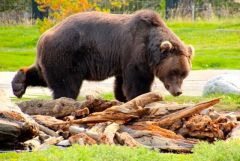RVing and Camping in Bear Country
Inevitably, if you do a lot of wilderness camping in your RV, you’re going to find yourself in bear country. It’s a sad fact of life that there are camping fatalities and injuries every year because of bear attacks and, during peak season, it's rare that at least one bear every week is not put down by game officials somewhere in North America because it strayed into a campground, usually because of irresponsible humans who left food out.
When we were in Yellowstone National Park this summer, that’s what happened to a black bear drawn to a campsite by watermelon.
If you travel with dogs, there can be other problems. Dogs antagonize bears, especially mother bears with cubs. You need to have your dog on a leash all the time its outside while you are in bear country.
But despite the headlines and all the warning signs, bear incidents are really rare and hundreds of thousands of campers and RVers enjoy wilderness camping deep in bear country without even seeing a bear. But that doesn’t mean precautions should not be taken.
Essentially, the bears most RVers will be near while wilderness camping are black bears and grizzlies. In Alaska and parts of far northern Canada, there are brown bears and, way north, polar bears. All bears must be considered dangerous. They are very powerful animals.
Black bears are most common. Grizzlies will be found in the west and northwest. Many of our western national parks have both. We’ve encountered black bears in Michigan’s Upper Peninsula, Tennessee, Montana and Wyoming. We’ve seen grizzlies in Wyoming and Montana.
We have never had an incident. But we take the rules very seriously.
When you camp in bear country, you will almost always see campground signs advising you that bears are in the area. Most national and state forest campgrounds also provide bear proof steel boxes for food storage. Same with garbage disposal – there’s usually bear proof containers. If your are boondocking in true wilderness or backcountry, you need to be extra careful in storing food and trash.
On our recent trip to Yellowstone, we had a black bear roaming about a meadow a hundred feet from where we were camped, Park workers were quick to arrive and began their normal hazing techniques, hollering and shouting and making a lot of noise to get the bear to move off. Wildlife managers told me they were worried the bear, who had been around for a couple of weeks, was becoming “habituated,” a term used used for a bear that had gotten used to being around people and does not respond to the presence of humans—they essentially ignore people but come closer and closer.
This, the hazing, called “aversive conditioning,” is aimed at making it uncomfortable for the bear to get too close to people. Habituated bears are more likely to learn that human structures, automobiles, campsites, and populated areas are possible sources of food, thereby becoming “food conditioned.” Getting into improperly stored human “food” (trash, etc) even just once can start a bear down this path.
Hazing makes a lot of noise. Sometimes, rangers will fire “poppers,” essentially loud firecrackers. They also can shoot the bear with “thumpers,” little beanbags that do no harm to an animal except startle them. Here’s a video shot at Yellowstone when a grizzly got too close to a group of people. You’ll hear the rangers tell everyone to get in their cars. Then they start yelling and firing poppers. The ‘griz ignored all of that. But the beanbag thumpers sent bim running.
As explained by the Sierra Club, a bear that has grown accustomed to human food may become aggressive toward people. If aversive conditioning techniques don’t work to break this cycle, and a bear continues to demonstrate aggressive behavior, resource managers are left no choice but to euthanize the bear. This cycle invariably begins with the unfortunate bear getting food from a careless or unknowing person.
We don’t want to see bears get put down. And we don’t want bears to put people in danger. From the National Parks Service and the Colorado Parks and Wildlife department, I’ve compiled the following rules and suggestions for RVing in bear country.
So here are the rules for camping in bear country:
- Never store food in or near your RV. After cooking and eating put all food inside.
- Keep the area clean. Be sure to wash dishes, dispose of garbage, and wipe down tables.
- Keep all items with strong odors (ie, toothpaste, bug repellent, soap, etc.) inside the RV and out of reach of bears or the bear-proof containers avialble at most campsites in bear country.
- Keep your dog on a leash or rope at all times. Never leave your dog outside at night while you sleep in the RV
- Close windows and lock your vehicle and RV when you leave your camp site and at night before you go to sleep.
- If a bear does come near your campsite and no rangers are around, get in your RV or vehicle, Yell at the bear. Honk the horn. Play loud music, bang pots and pans. Do not try to approach it.
- If you will be spending time in bear country, get a can of bear spray. Bear spray is a super-concentrated, highly irritating pepper spray proven to be more effective than firearms at deterring bears.
Most bear encounters do not happen in campgrounds. They happen in the backcountry while people are hiking.
You should never hike alone. Two or three people are best.
Bears will usually move out of the way if they hear people approaching, so make noise. Most bells are not enough. Calling out and clapping hands loudly at regular intervals are better ways to make your presence known. Hiking quietly endangers you, the bear, and other hikers. A bear constantly surprised by quiet hikers may become habituated to close human contact and less likely to avoid people. This sets up a dangerous situation for both visitors and bears.
General hiking precautions in bear country:
- Tracks, bear scat, and shredded logs are all signs you’re in bear country.
- Be alert at all times, and leave your headphones at home. Be extra cautious at dawn and dusk, when the wind is in your face, visibility is limited or you’re walking by a noisy stream. A firm clap or quick shout warns bears that humans are in the area.
- In late summer and fall, bears need to forage up to 20 hours a day, so avoid trails that go through berry patches, oak brush and other natural food sources.
- Keep dogs leashed; exploring canines can surprise a bear. Your dog could be injured, or come running back to you with an irritated bear on its heels. Many National and State Parls prohibit dogs i=on hiking trails.
- Keep children between adults, and teach them what to do if they see a bear. Don’t let them run ahead or fall behind.
- Double bag food, and never leave any trash or leftovers behind. Finding treats teaches bears to associate trails with food.
- Never approach bears or offer food. If you’re lucky enough to see a bear, watch from a safe distance and enjoy this very special experience. If your presence causes the bear to look up or change its behavior in any way, you’re too close.
If you do encounter a bear:
- Stand still, stay calm and quietly back away leave. Do not make aggressive eye contact. Talk in a normal tone of voice. Be sure the bear has an escape route.
- Never run or climb a tree.
- If you see cubs, their mother is usually close by. Leave the area immediately.
- If a bear stands up, it is just trying to identify what you are by getting a better look and smell.
- Wave your arms slowly overhead and talk calmly. If the bear huffs, pops it jaws or stomps a paw, it wants you to give it space.
- Step off the trail to the downhill side, keep looking at the bear and slowly back away until the bear is out of sight.
If the bear approaches:
- A bear knowingly approaching a person could be a food-conditioned bear looking for a handout or, very rarely, an aggressive bear. Stand your ground. Yell or throw small rocks in the direction of the bear.
- Get out your bear spray and use it when the bear is about 40 feet away.
- If you’re attacked, don’t play dead. Fight back with anything available. People have successfully defended themselves with pen knives, trekking poles, and even bare hands.







0 Comments
Recommended Comments
There are no comments to display.
Please sign in to comment
You will be able to leave a comment after signing in
Sign In Now